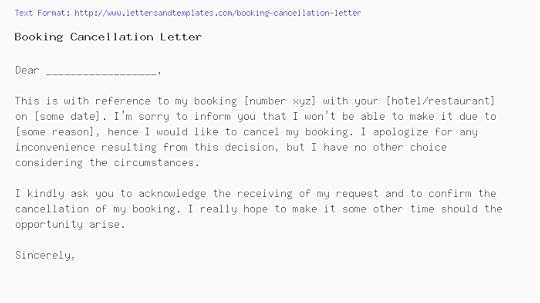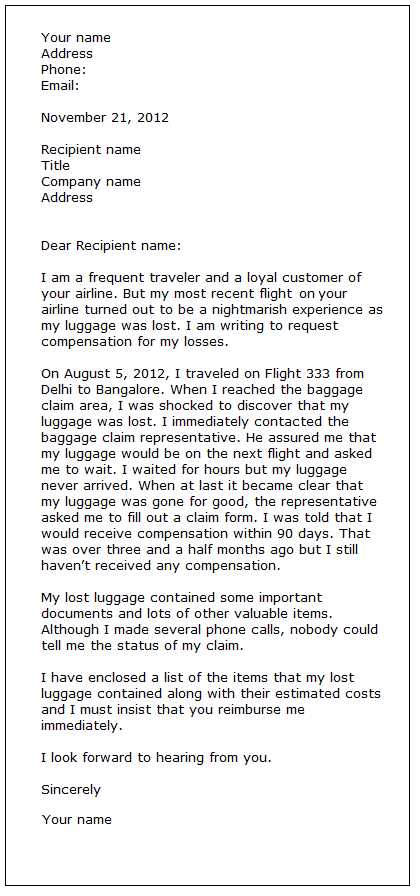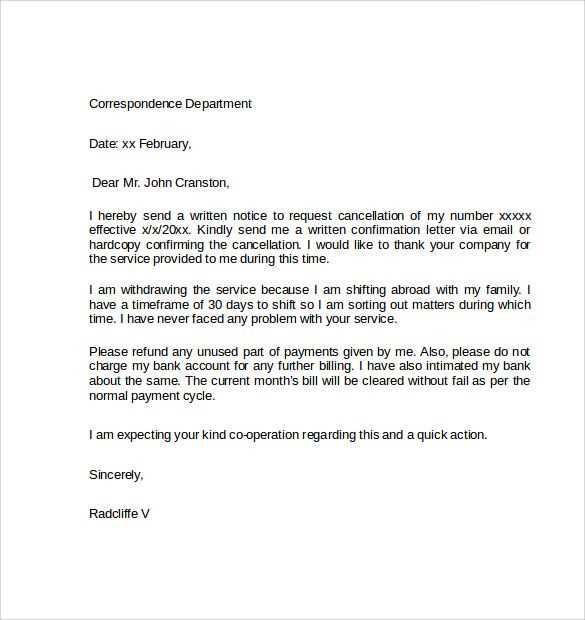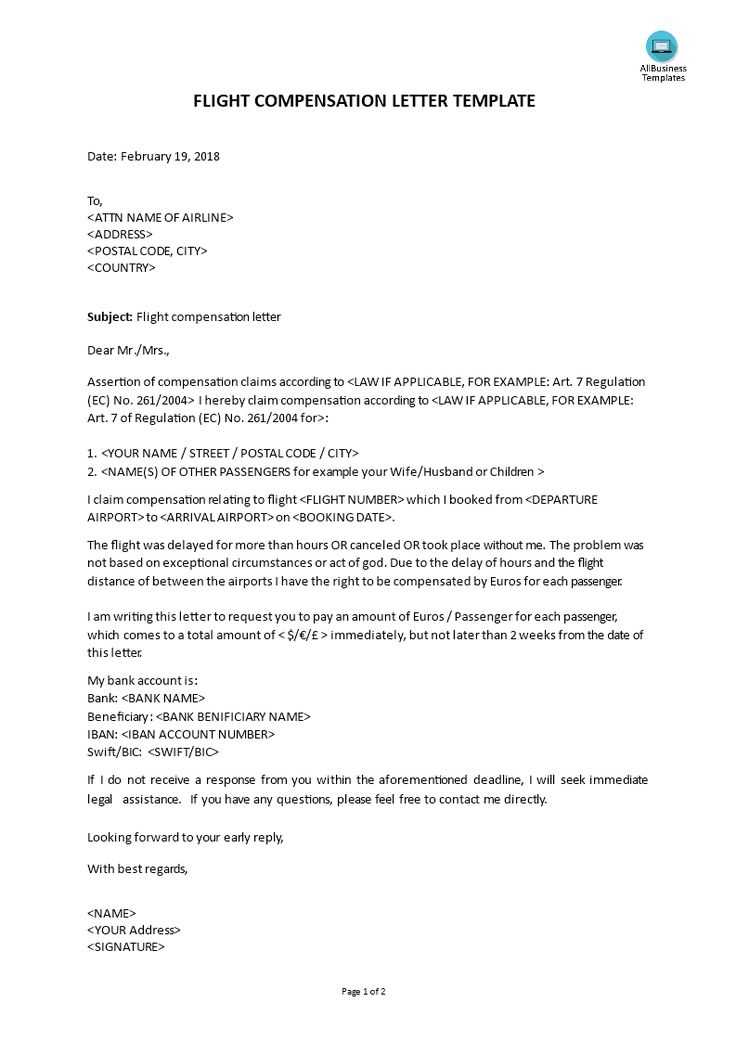Cancelled flight compensation letter template

If your flight is cancelled, you have the right to compensation. It’s crucial to act quickly and clearly state your request for reimbursement. A well-written compensation letter can significantly increase your chances of receiving what you’re owed. Below is a straightforward template to help you get started with your letter.
Start by including your flight details. Clearly state your flight number, date of cancellation, and any alternative arrangements made by the airline. If you were not offered a suitable alternative, mention that too. This ensures the airline understands the disruption you experienced.
Example: “I was booked on flight XYZ123, scheduled for departure on January 15, 2025, from New York to London. Unfortunately, this flight was cancelled without prior notice, and I was not offered an alternative within a reasonable time frame.”
Next, outline your compensation request. Refer to the airline’s policies or relevant regulations, such as EU or US flight compensation laws, to back up your claim. You can mention the specific compensation amount you expect, such as reimbursement for ticket costs, additional expenses, or compensation for the delay caused.
Example: “Under EU Regulation 261/2004, I am entitled to compensation for the inconvenience caused by this cancellation. As my flight was over 3 hours delayed and no alternative arrangements were made, I request compensation of €250 as specified by the regulation.”
Lastly, close your letter with a clear request for a response and specify a reasonable time frame for them to process your claim. Remain professional and polite, keeping the tone constructive.
Example: “I kindly ask you to process my compensation request within the next 14 days. Should you require any additional information, please do not hesitate to contact me.”
Here’s the corrected version with repetitions removed:
When you encounter a canceled flight, your first step is to check the airline’s policy on compensation. Airlines are often obligated to offer compensation depending on the circumstances surrounding the cancellation.
Start by collecting all relevant details of your flight, including the booking reference, flight number, and the reasons provided by the airline for the cancellation. This information is essential for processing your compensation request.
Next, write a clear and concise letter to the airline. Be polite, but firm in stating your expectations. Include your contact information and a request for compensation, referencing the applicable regulations and any entitlement you may have. Ensure to specify the compensation you are seeking, whether it’s a refund, alternative flight, or other reimbursement options.
Provide any necessary supporting documents, such as a copy of your booking and correspondence with the airline. This will help the airline verify your claim and speed up the process.
Keep records of all communications. If the airline fails to respond promptly, follow up with a reminder. If necessary, consider escalating the issue through consumer protection organizations or regulatory bodies.
| Step | Action |
|---|---|
| 1 | Check the airline’s compensation policy |
| 2 | Gather your flight details and cancellation reasons |
| 3 | Write a clear compensation request letter |
| 4 | Include supporting documents |
| 5 | Follow up if necessary |
Staying organized and persistent increases your chances of a successful compensation claim.
- Cancelled Flight Compensation Letter Template
If your flight was cancelled, you have the right to seek compensation from the airline. Below is a letter template that can help you communicate your claim clearly and professionally. This letter should be sent to the airline’s customer service department.
Template

Dear [Airline Name] Customer Service,
I am writing to formally request compensation for the cancellation of my flight [Flight Number] scheduled on [Date]. Unfortunately, this cancellation has caused significant inconvenience and disruption to my travel plans.
The details of my booking are as follows:
- Full Name: [Your Full Name]
- Booking Reference: [Booking Reference Number]
- Flight Number: [Flight Number]
- Original Departure: [Departure City, Time]
- Destination: [Arrival City]
As per [EU Regulation 261/2004 or other applicable legislation], I am entitled to compensation for the disruption caused by the flight cancellation. The delay has caused me financial loss and inconvenience, and I kindly request compensation in the amount of [specific amount or details about the compensation you are entitled to, such as refund, vouchers, or reimbursement of expenses].
Thank you for your attention to this matter. I look forward to receiving confirmation of my compensation request and your prompt resolution of this issue.
Sincerely,
[Your Full Name]
[Your Contact Information]
Additional Tips
Always make sure to keep a record of your communication with the airline. If you do not receive a response within a reasonable time frame, consider following up or submitting a complaint to the relevant aviation authority.
Begin your compensation request letter with a clear and concise statement. Include the necessary details right away: your full name, contact information, flight details (flight number, date, and origin/destination), and the reason for your request. A straightforward opening allows the airline to quickly identify your case and respond efficiently.
Be Specific with Your Flight Information
Make sure to include your booking reference or ticket number. This helps the airline trace your booking in their system. Avoid vague references, such as only stating your destination; include all relevant details to prevent delays in processing your request.
State the Issue Clearly

Describe the reason for the cancellation. If the airline hasn’t provided you with an explanation, simply state the cancellation and its impact on your travel plans. Be factual and stick to the key details to ensure your letter is focused and actionable.
Provide the flight details right at the beginning of the letter. Include your booking reference, flight number, and date of the cancelled flight. This will help the airline quickly locate your booking and understand the situation.
Clearly state the cancellation and how it impacted your travel plans. If you were informed late or did not receive proper notice, mention the time you were notified. Be specific about how the delay or cancellation affected your arrival time, missed connections, or additional costs incurred.
Detail any costs or inconveniences you faced due to the cancellation. If you had to book alternative transportation, accommodation, or food, include receipts or estimates for reimbursement. This shows the financial impact the cancellation had on you.
Request compensation based on the airline’s obligations. Refer to the relevant regulations or policies, like EU 261/2004 or similar, to back your claim. State the compensation you are seeking, whether it’s a refund, reimbursement for expenses, or compensation for the delay.
Include your contact information for follow-up. Provide a phone number or email where the airline can reach you with updates or questions. This ensures they can process your claim efficiently.
Finish the letter with a polite yet firm request for a timely resolution. Give the airline a reasonable deadline to respond to your claim to show that you expect prompt action.
Begin by identifying the correct contact details for the airline. Use the address or email specified for complaints or customer service on the airline’s website. If you’re unsure, look for the “Contact Us” section or check for any official correspondence related to your flight.
In your letter, direct your communication to a specific department, such as “Customer Service” or “Claims Department,” to ensure it reaches the right team. If possible, address the letter to a person by name. This may involve calling the airline’s support team beforehand or checking any previous communication from them.
Start with a formal salutation like:
- Dear Customer Service Team,
- Dear [Airline Name] Claims Department,
- To Whom It May Concern,
If you’ve been in direct contact with a representative or a specific department before, refer to them by name, for example: “Dear Mr. Smith” or “Dear [Team Name].” This personal touch can create a more direct connection to your case.
Be sure to use the airline’s official name in full and avoid abbreviations. If you’re addressing an international airline, check if the country-specific branch has a different address or contact. This helps to avoid delays in processing your claim.
Start by citing the relevant laws that support your claim. For flights within the European Union, refer to EU Regulation 261/2004. This regulation ensures passengers are entitled to compensation for cancelled flights, unless the cancellation is due to extraordinary circumstances. Specify the distance of your flight and its delay to determine the amount of compensation due.
If the flight was departing from the EU or operated by an EU carrier, you are likely entitled to compensation based on the flight’s length. For short flights (under 1500 km), the compensation is typically €250, while for longer distances, the amount increases.
For flights within the United States, you may invoke the U.S. Department of Transportation’s rules. While there’s no set compensation for cancellations, passengers should be provided with rebooking options or a full refund. If your flight was overbooked, mention the regulations regarding denied boarding compensation.
Be clear about the time of cancellation. If your flight was cancelled less than 14 days before departure, compensation is likely owed unless the airline can prove the cancellation was due to weather or other extraordinary factors beyond their control.
Always include the specific details of the incident and reference the law to strengthen your case. This will show the airline that you are well-informed about your rights and expect fair treatment in accordance with legal standards.
To calculate the compensation for a canceled flight, first, check the distance of your trip. Compensation amounts vary based on flight distance and the timing of the cancellation. European regulations set the following compensation guidelines:
- For flights under 1,500 km, the compensation is up to €250.
- For flights between 1,500 km and 3,500 km, you may receive up to €400.
- For flights longer than 3,500 km, the compensation is up to €600.
Next, determine how long before your scheduled departure the airline notified you about the cancellation. If they informed you at least 14 days before, you are not eligible for compensation. However, if they notified you within 7 to 14 days, the compensation amount may be reduced by 50%. If the cancellation occurs less than 7 days before departure, you are entitled to the full compensation amount.
In some cases, the airline might offer you an alternative flight. If you choose to accept a later flight, the compensation may also be reduced, depending on the delay. If the delay is longer than 4 hours, you still qualify for full compensation, even if you accept the new flight option.
Keep in mind that extraordinary circumstances such as bad weather, security risks, or political instability may exempt the airline from paying compensation.
If your compensation request is denied, carefully review the airline’s response to understand their reasoning. Look for any specific conditions or regulations they cite that may impact your claim. If the rejection seems unjust, consider appealing the decision. Many airlines have an internal dispute resolution process, so gather any additional evidence you can, such as communication records or further proof of the delay’s cause, and submit a well-documented appeal.
If the airline refuses to reconsider, contact a relevant national or international regulatory authority, such as the Civil Aviation Authority in the UK or the Department of Transportation in the US. File a formal complaint with the regulatory body, providing all relevant details and documentation to support your case.
In some cases, you may need to seek legal advice. A lawyer specializing in consumer rights or aviation law can help assess whether you have grounds to take further legal action, including pursuing a claim in small claims court. Keep in mind that your chances of success are higher if you can demonstrate a clear violation of your rights under consumer protection laws or aviation regulations.
Cancelled Flight Compensation Letter Template
Begin by addressing the airline with a formal salutation, such as “Dear [Airline Name] Customer Service.” Clearly mention your flight details, including the flight number, date, and route. State that your flight was cancelled and specify how long in advance you were notified. If applicable, include any inconvenience or disruption caused by the cancellation, like missed connections or planned events.
Request for Compensation
Next, explain your rights regarding compensation. Reference the relevant regulation (e.g., EC 261/2004 for EU flights or any other applicable laws for your region). Politely state that you are requesting compensation due to the cancellation and request the amount or voucher per the law. Attach any supporting documents such as your booking confirmation, boarding pass, and any proof of additional expenses incurred due to the cancellation.
Closing Remarks

End your letter by thanking the airline for their attention to the matter. Request a response within a specific timeframe (e.g., 14 days). Include your contact details for further communication. Sign off respectfully with “Sincerely” or “Kind regards,” followed by your name.